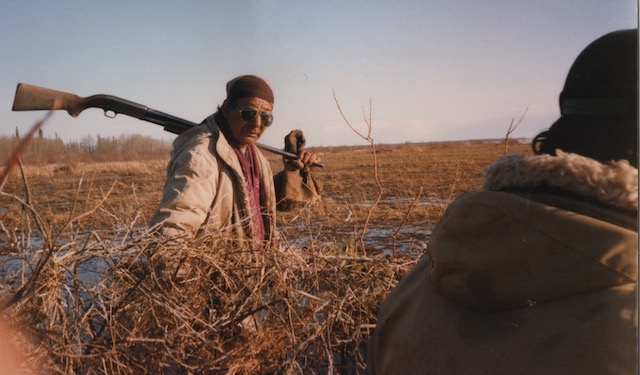The age-old art of the hunt is now in full swing in James Bay. Cree families have scattered throughout the territory, leaving the streets of their towns nearly empty. Hunters, young and old, male and female, are sitting quietly and patiently in their blinds scanning the southern horizon for the annual return of their national and cultural symbol – the goose. Which also happens to be extremely tasty.
The Cree hunting story is another age-old art that still thrives. Our fathers and their hunting partners coming home at dusk would sit down to eat. Then, lighting their pipes, they would recount their day. Their stories, mind you, weren’t just for mere entertainment; they were told to instruct, inform and guide one’s guest along the lay of the land of their territory.
Then there are those stories that are retold year after year, decade after decade, until their details and names grow faint. So, without further ado…

One day, near the Nottaway River close what was then known as Rupert House, an old man came upon a lone gosling. He took it back to his camp and fed it. After some time, the gosling grew strong enough to fly. The old man raised the bird through the winter, feeding it from what he had gathered along the river’s shores.
That spring, the old man took the young goose with him to his hunting blind and left it out among the decoys. A large flock soon appeared and glided down to land on the water. The old man watched to see what his goose would do. As the geese called, the young goose flew, frightened by their calls. into his blind.
He took his bird out with the decoys again and this time when geese were seen it started to honk. Flocks and flocks of geese flew towards the blinds all spring and the old man shot many. Other times, the bird would merely flap its wings and more geese would come.
The goose lived with the family for another winter and in the autumn the old man left his bird out where they hunted, hoping it would join the southbound flocks. But when the old man came out of his teepee the following morning, he discovered his goose had flown back to him. He tried again, taking it further away before leaving it. There was no sign of the goose the next day. Over the passing spring and autumn nights, as the flocks were heard flying over, the old man in an almost sad voice would wonder aloud, “I wonder where my pet is. I wonder if it survived this year.”

Some hunters, for various reasons, begin their training late in life. One Mohawk gentleman married into a Cree family. One spring a friend offered to teach him to hunt geese.
As they were getting ready to head out in the morning, geese suddenly appeared over their camp. The hunters rushed out with their shotguns and fired. One of the geese fell wounded in the nearby rushes and their dog “Kwekwe” quickly retrieved it. There was a friendly argument as to who had brought it down. Alan, the experienced Cree hunter, showed the new hunter how to kill a wounded goose. He placed his knee on the bird’s back until it stopped flapping. Alan then taught his friend how to tell how fat the goose was by plucking a few feathers off its stomach and giving the skin a light pinch. After placing the dead bird in their freezer, the two went out on the ice for the real hunt.
Later that day, their friend Bernard returned to the camp to fetch something. When he opened the freezer, the goose honked weakly and flew out, nearly knocking Bernard’s hat off his head. The goose headed for the bush with Bernard trailing. “Alan! The goose is still alive!” Kwekwe saw what was happening and raced after the goose through the bushes and quickly brought it back.

It was late spring, and a hunter was warming himself in his sunny blind as he waited for a target. There were few geese and ducks flying that late in the season, so he decided on a stroll. The snows had melted away and the water was high in the muskeg. As he walked with eyes alert to any nearby birds, his foot landed in a deep opening in the bog and he splashed into the cold water. He emerged safe, but with all his clothes dripping wet. He wondered if he should risk a cold and the inevitable laughter and hurry home to dry off.
It being warm and still early in the day the hunter undressed and spread his coat, shirt and pants over his blind to dry. He sat there half naked in his underwear. It was very uncomfortable sitting in wet briefs, so he also took them off, wrung them out and hung them to dry. He sat there naked, armed and extremely dangerous, hoping another hunter wouldn’t happen by. No geese came to our naked hunter that day. Perhaps they could spot the untanned parts of his body from far off and turned away.
The moral of these stories? Be certain your goose is actually dead before you attempt to freeze it. Bring warm and clean underwear when out hunting. And finally, if you love something, set it free. If it comes back, it’s yours. If it doesn’t, it never was.





